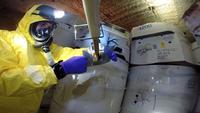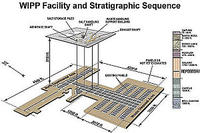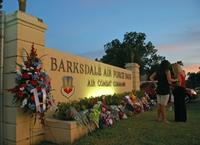-
A second drum at nuke waste repository poses radiation leak danger

At a recent meeting of the New Mexico Legislature’s Radioactive and Hazardous Materials Committee in Carlsbad, officials were informed that a second waste drum containing nuclear materials, could also contain the same mix of ingredients as the waste drum from Los Alamos National Laboratory (LANL) which caused a radiation leak at the Waste Isolation Pilot Plant (WIPP) in February.
-
-
Deficiencies in U.S. nuclear labs’ emergency preparedness plans: Report
A recently released study of seventeen U.S. nuclear weapons laboratories by the Defense Nuclear Facilities Safety Board(DNFSB), which examined operations at the labs over the last three years, found deficiencies in emergency preparedness plans. Three New Mexico labs — the Los Alamos National Laboratory(LANL), the Waste Isolation Pilot Plant(WIPP) near Carlsbad, and Sandia National Laboratoriesin Albuquerque — exemplify various gaps in disaster preparedness throughout the nation’s nuclear defense system.
-
-
Strengthening the armor for nuclear-waste eating microbes
A microbe developed to clean up nuclear waste and patented by a Michigan State University researcher has just been improved. Researchers had identified that Geobacter bacteria’s tiny conductive hair-like appendages, or pili, did the yeoman’s share of remediation. By increasing the strength of the pili nanowires, she improved their ability to clean up uranium and other toxic wastes.
-
-
Los Alamos conducts hydrodynamic experiment in Nevada
Los Alamos National Laboratory has successfully fired the latest in a series of hydrodynamic experiments at the Nevada National Security Site (NNSS). Hydrodynamic experiments involve non-nuclear surrogate materials that mimic many of the properties of nuclear materials. The12 August 2014 integrated experiment, nicknamed “Leda,” provided important surrogate hydrodynamic materials data which support the laboratory’s role as a steward of the U. S. nuclear deterrent.
-
-
U.S. to spend more money on modernizing its nuclear arsenal, less on nonproliferation programs
President Barack Obama has made gains in his quest to secure nuclear weapons and materials. In March, at the Nuclear Security Summitin Holland, Obama declared “it is important for us not to relax but rather accelerate our efforts over the next two years.” The Obama administration, however, is allocating more resources toward refurbishing and modernizing current nuclear weapons than advancing nuclear nonproliferation programs. Civilian institutions, including research labs, today hold enough nuclear explosive materials to put together 40,000 atomic bombs, but the administration has missed a self-imposed deadline of April 2013 for ensuring that nuclear materials were safe from terrorist organizations.
-
-
Continued funding for S.C. mixed-oxide fuel (MOX) plant – at least until fall
Federal legislators have secured the funds to keep the mixed-oxide fuelplant (MOX) at the Savannah River Sitein South Carolina moving forward at least into fall, according to South Carolina governor Nikki Haley and members of the state’s congressional delegation. The 310-square mile site once produced components for nuclear weapons, but since the agreement with Russia to turn nuclear weapons into reactor fuel, the site has focused on repurposing and cleanup.
-
-
Sandia makes sure U.S. nuclear weapons deterrent remain effective, credible
It may sound strange to say that nuclear weapons must survive radiation. Sandia National Laboratories says, however, that as part of its mission of ensuring the nation’s stockpile is safe, secure, and effective as a deterrent, the laboratory must make sure crucial parts can function if they are hit by radiation, especially a type called fast neutrons. Sandia developed a new way to do that after its facility for creating fast neutrons, the Sandia Pulsed Reactor (SPR), was shut down due to increased post-9/11 security concerns about its highly enriched uranium.
-
-
DOE chief to visit WIPP to discuss funding for recovery efforts

Energy Secretary Ernest Moniz will visit Carlsbad, New Mexico on 12 August to discuss funding for the Waste Isolation Pilot Plant (WIPP) recovery efforts.Traces of americium and plutonium were released from a nuclear waste drum on 14 February and were detected in the air almost a half-mile outside WIPP. On 15 May, the DOE confirmed that the damage occurred on a waste drum from Los Alamos National Laboratory.
-
-
Fire shuts down nuclear repository, but DOE still recognizes operator for “excellent” performance
Five days after an underground truck fire closed the Waste Isolation Pilot Plant (WIPP), the Energy Department (DOE) awarded Nuclear Waste Partnership (NWP), the operating contractor of the nuclear repository, $1.9 million for “excellent” performance during the past year.Shortly after the truck fire, WIPP was shut down because of radiation leak, Still, “No federal or contractor official has lost their job, been transferred, been moved off the WIPP contract or otherwise held accountable. No leadership has changed at the federal level. No company has lost a contract,” noted an industry observer.
-
-
Barksdale AFB to be upgraded so it could store nuclear weapons on site

In 2009, the Louisiana congressional delegation successfully fought for locating the Global Strike Command at Barksdale Air Force base. Barksdale, home to the Global Strike Command, is No. 2 on the Air Force’s priority list of nuclear weapons storage areas set to receive an upgrade so Barksdale can safety store the U.S. nuclear weapons and load the weapons onto B-52s. The B-52s stationed at Barksdale AFB currently fly to other installations to load nuclear weapons onboard. Language inserted last week into the bill that funds the Department of Defense (DOD) for FY15 requires the Air Force to develop a detailed plan within ninety days of the bill becoming law on how it will modernize the U.S. five nuclear weapons storage areas, including the one at Barksdale Air Force Base.
-
-
Game of marbles inspires nuclear-inspection protocol

Modern cryptography combined with simple radiation detectors could allow nuclear-weapons checks to be carried out with almost complete security. That is the conclusion of scientists in the United States, who have used computer simulations to show how a beam of neutrons can establish the authenticity of a nuclear warhead without revealing any information about that weapon’s composition or design.
-
-
Engineering nuclear nonproliferation

University of Virginia engineering professor Houston Wood’s career demonstrates the important role that engineers can play in making the world a safer place. For more than two decades, Wood has helped governments determine whether nuclear programs in other parts of the world are being dedicated to peaceful or military purposes. In recent years, Wood has been working to determine the break-out time that Iran would require to develop a nuclear weapon if it stopped allowing the International Atomic Energy Agency IAEA) to inspect its nuclear facilities.
-
-
A farewell to (nuclear) arms: A novel technique could facilitate nuclear disarmament
A proven system for verifying that apparent nuclear weapons slated to be dismantled contained true warheads could provide a key step toward the further reduction of nuclear arms. The system would achieve this verification while safeguarding classified information that could lead to nuclear proliferation. Their novel approach, called a “zero-knowledge protocol,” would verify the presence of warheads without collecting any classified information at all.
-
-
Badly engineered missile defense systems deployed “because there was a rush”
In 1983 President Ronald Reagan launched the Strategic Defense Initiative (SDI) to build space- and ground-based missile defense systems. The space-based component was abandoned as impractical, and the focus shifted to Ground-based Midcourse Defense systems (GMD). Despite disappointing results and program test failures, Congress and the George W. Bush administration pressed forward with spending billions on acquiring systems of questionable reliability. “We recognize the problems we have had with all the currently fielded interceptors,” Undersecretary of Defense Frank Kendall old an industry gathering in February 2014. “The root cause was a desire to field these things very quickly and very cheaply; we are seeing a lot of bad engineering, frankly, and it was because there was a rush.”
-
-
Number of world’s nuclear weapons reduced, but modernization continues
The overall number of nuclear weapons in the world continues to decline, but none of the nuclear weapon-possessing states are prepared to give up their nuclear arsenals for the foreseeable future. At the start of 2014 nine states — the United States, Russia, the United Kingdom, France, China, India, Pakistan, Israel, and North Korea — possessed approximately 4000 operational nuclear weapons. If all nuclear warheads are counted, these states together possessed a total of approximately 16,300 nuclear weapons compared to 17,270 in early 2013.
-